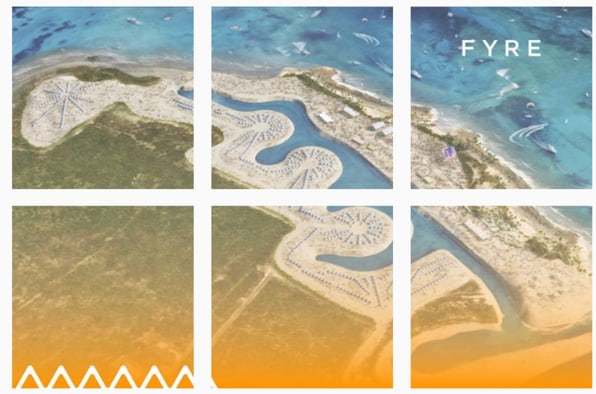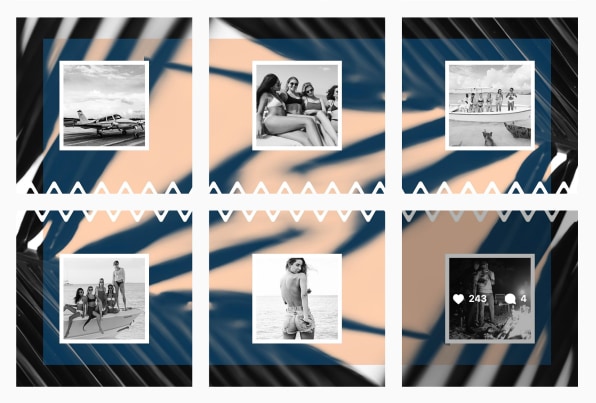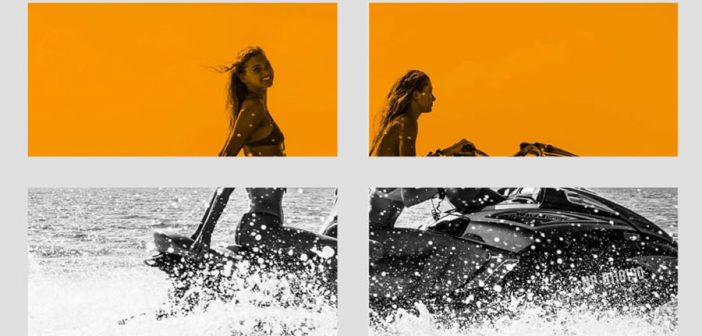“From the start, the brief wasn’t really a brief. It was just: This is our audience, this is what we’re trying to sell them.”
We’re living in a cultural moment obsessed with scams. From the HBO documentary on Elizabeth Holmes and Theranos to Netflix and Hulu’s dueling documentaries on Fyre Festival, con artists have captured the popular imagination.
In the case of both Theranos and Fyre, branding played an important role. Holmes was able to make people believe in her fictional technology in part because of the strength of her personal brand coupled with the prestige of her industrial designer, Yves Béhar (who coincidentally has participated in a number of failed products beyond Theranos).
For Fyre, it was a lesser-known designer named Oren Aks, who played an instrumental role in convincing people that buying a ticket to Fyre would mean buying the chance to party in opulent Bahamas beach villas with Kendall Jenner. The festival’s glamorous brand, portrayed through its trailer and its Instagram feed, which was supported by a dozens of influencers like Jenner, Bella Hadid, and Hailey Baldwin, was the primary way most would-be attendees heard about the event. Of course, when these would-be festival-goers arrived on the island, there wasn’t enough food or shelter. The disaster earned the festival’s founder, Billy McFarland, six years in jail.
I sat down with Aks to talk about designing a brand for a product that didn’t exist, and whether he feels responsible for the role he played in convincing people to buy Fyre Festival tickets. The conversation underlines the role design can play in selling almost anything–and the ethical problems involved when it does.

ON THE FYRE BRIEF
The Fyre Festival’s immensely effective branding was the work of Aks, a graphic designer and cofounder at the social media agency Jerry Media, which was founded on the back of the popular Instagram account FuckJerry. After graduating from San Francisco’s Academy of Art University with degrees in advertising and graphic design, Aks worked at a few startups before getting a job as an editorial graphic designer at Thrillist. Soon after, he joined Jerry Media and quickly began to work with the company’s first client: Fyre.
“From the start, the brief wasn’t really a brief. It was just: This is our audience, this is what we’re trying to sell them,” he says.

Who was the target audience for this campaign? “You don’t have to be an influencer, but you’re this New Yorker kid who knows everything, goes out to all the new places, vacations frequently, ticks all the boxes of the wannabe influencer on Instagram,” Aks says. “It was for the influencers and for the wannabe influencers and their community. The package was that lifestyle just bottled up.”
Aks says that he created the brand out of a logo, colors, and a pile of stock assets.
“It just was given to me with the brand assets, like the colors. And that was kind of it: the logo, two colors, dark blue, and the orange. The generic crowd . . . it’s stock content, the video is stock, the music was actually a track that they didn’t have licensing to at the time. It was Missy Elliott and Kaytranada. I actually voiced that: We’re going to get flagged by Instagram. This isn’t going to even get past their algorithm. So we’ve got all these, like, random assets. Nothing was original and nothing was finalized. So I have this pile of nothing.”
The feed Aks created (which you can still scroll through on Fyre Festival’s official Instagram page) is a mix of orange and blue graphics with images of models and palm fronds, many of which feature an orange zig-zag or the festival’s flame logo. It’s clearly an advertisement for a utopian getaway (at least for straight men).
But Aks’s crowning achievement wasn’t the feed; it was the idea to pay dozens of influencers to post a solid orange square on Instagram at the same time as a way of announcing the festival.

ON BRANDING A SCAM
The brand identity was so successful that Fyre sold out all its tickets, including those for the grandiose villas that would never be built. Aks doesn’t think that his branding influenced people’s emotions or that it’s what ultimately convinced people to buy tickets to Fyre. “I’m not doing market research and studying lab rats and how the mind works,” he says. “We’re literally just holed up in SoHo, a bunch of Instagram kids that are just fucking around.”
But he does admit that the brand was able to effectively conjure emotions–feelings of fear of missing out (FOMO), in particular:
“There were influencers going and it’s another emotional connection. It’s not a branding situation when you see the Jenners are going, and you’re like, it’s going to be awesome. That’s not really branding. It’s like an emotional thing. There’s a very fine line where the two meet. I think a lot of it was FOMO. That was a thing we did discuss as a selling point. It’s not something that is really branding. FOMO is again more on the emotional side. It’s its own thing . . .
So I think we tapped into emotional situations. Like, yeah we’re going to use these influencers because we know we want to tap into a good time or this photo because we want to invoke this vibe. We’re talking vibe, emotion. These are all separate from visuals. I think what people see is up to them.”

ON HAVING REGRETS
While Aks says he “would definitely have done it differently” if he had known where the Fyre Festival was headed, he stops short of taking any responsibility for the scam.
“I think that the easy, surface thing to say is to blame everybody involved but there’s people that just were coming to work. I was at [Jerry Media] at the time as a graphic designer. I had no idea what my boss was up to, what the financial situation between him and our client looked like. And when I did, I raised the alarm, being like, hey, we haven’t been paid a quarter million dollars in three months. As a cofounder, I have enough care in my own future in the company that those were things that I brought up.
So I brought things up to the best of my general knowledge of what I saw in front of me. I think that’s all I could do. A lot of people got screwed because of giving too much trust down in the the Bahamas or locally. It’s just one of those situations where it’s a human interaction where trust is a common factor, where you just give everybody you know that benefit and then nobody expects, like I said, a festival to crash and burn like this. Maybe now if we were talking about a new festival you might double check this because there was a festival once upon a time that sounded like this, and ended up like that . . .
I don’t like that I was involved in it. I would definitely have done it differently. I don’t like that people were affected locally in the Bahamas. I don’t like that people here that I know were affected. People were shook up. I don’t really think regretting it now makes sense because it’s too late. It’s more just looking back now, realizing what has happened, learning from it, and taking that to the next project, the next client, and sharing what I know.”
Aks later participated in the Hulu documentary about Fyre. He calls Netflix’s own documentary “a polished turd,” reasoning that it was produced by Jerry Media to make the company look good. He’s currently working on a memoir about his experiences at Jerry Media that’s supposed to illuminate what it was like to work on the festival, via his texts, Slack messages, and email threads. Despite Aks’s insistence that it wasn’t his visuals that convinced people to buy tickets, the fact that the marketing campaign went viral suggests that Fyre’s brand and advertising did sway people, convincing them to spend hundreds or thousands of dollars on something that didn’t exist.
It also points to the enduring problem of what you might call vaporware (or a marketing campaign for a product that doesn’t really exist). It’s getting harder and harder for people to discern what is real and what is not. For most people who were scammed by the Fyre Festival, the festival’s existence was shaped solely by its social media feed and website–until they arrived in the Bahamas, and found that you can’t always believe what you see on Instagram.
–
This article first appeared in www.fastcompany.com
Seeking to build and grow your brand using the force of consumer insight, strategic foresight, creative disruption and technology prowess? Talk to us at +9714 3867728 or mail: info@groupisd.com or visit www.groupisd.com


